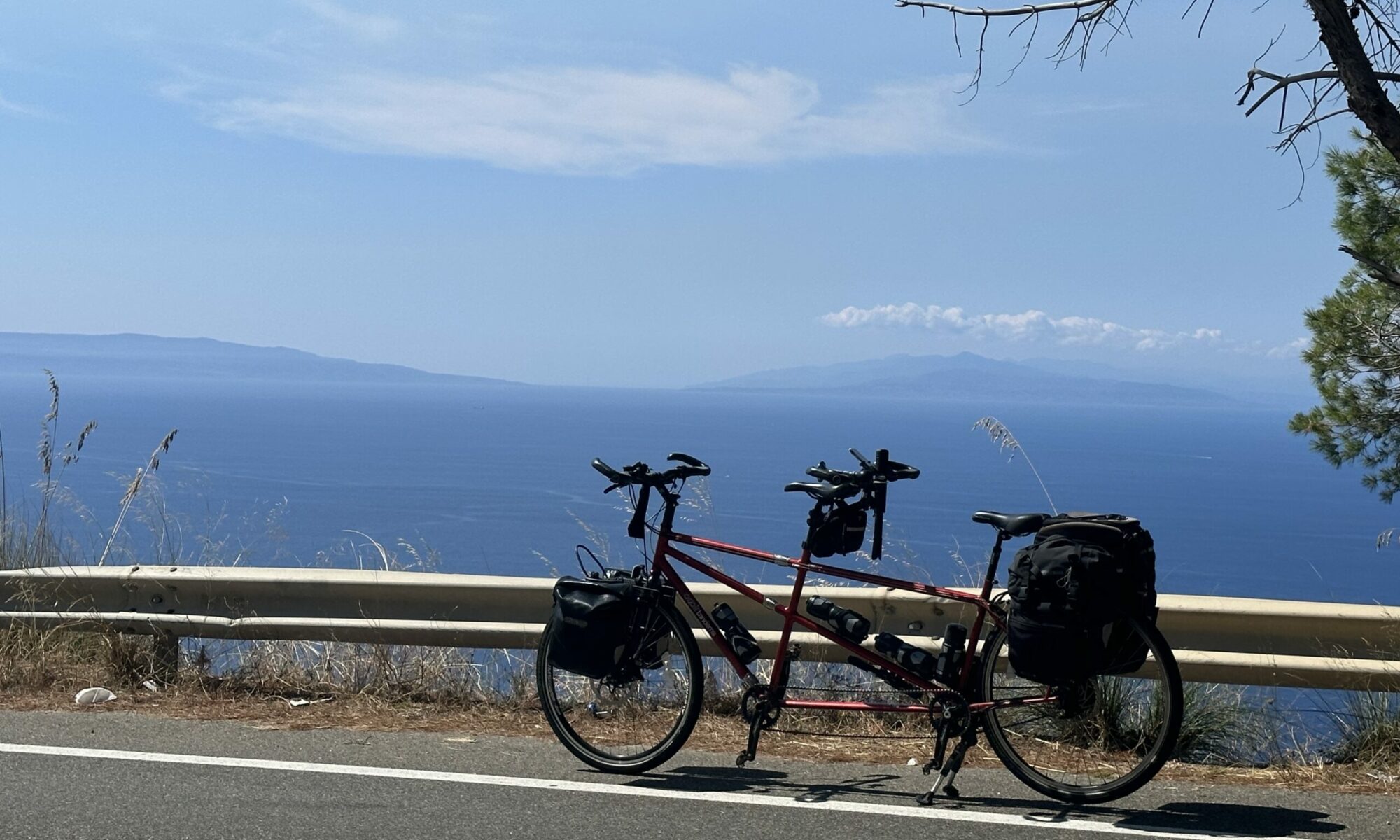Around 40km outside Agra we stopped at Fatehpur Sikri, a red sandstone fort/palace built by the third Mughal emperor, Akbar. It was abandoned for the fort/palace at Agra itself, due to a simple lack of water. Well, a lack of enough water to service the needs of an emperor, his three wives, countless concubines and all the staff who looked after all of them!
It was in remarkable condition, all the intricate Mughal-style intricate carvings still very sharp after all these years. The local red sandstone is extremely hard, not what we Westerners expect after our experience of softer sandstone at home. The remains had been looted of any gold and precious stones, of course, but it was easy to imagine the opulence in its heyday.
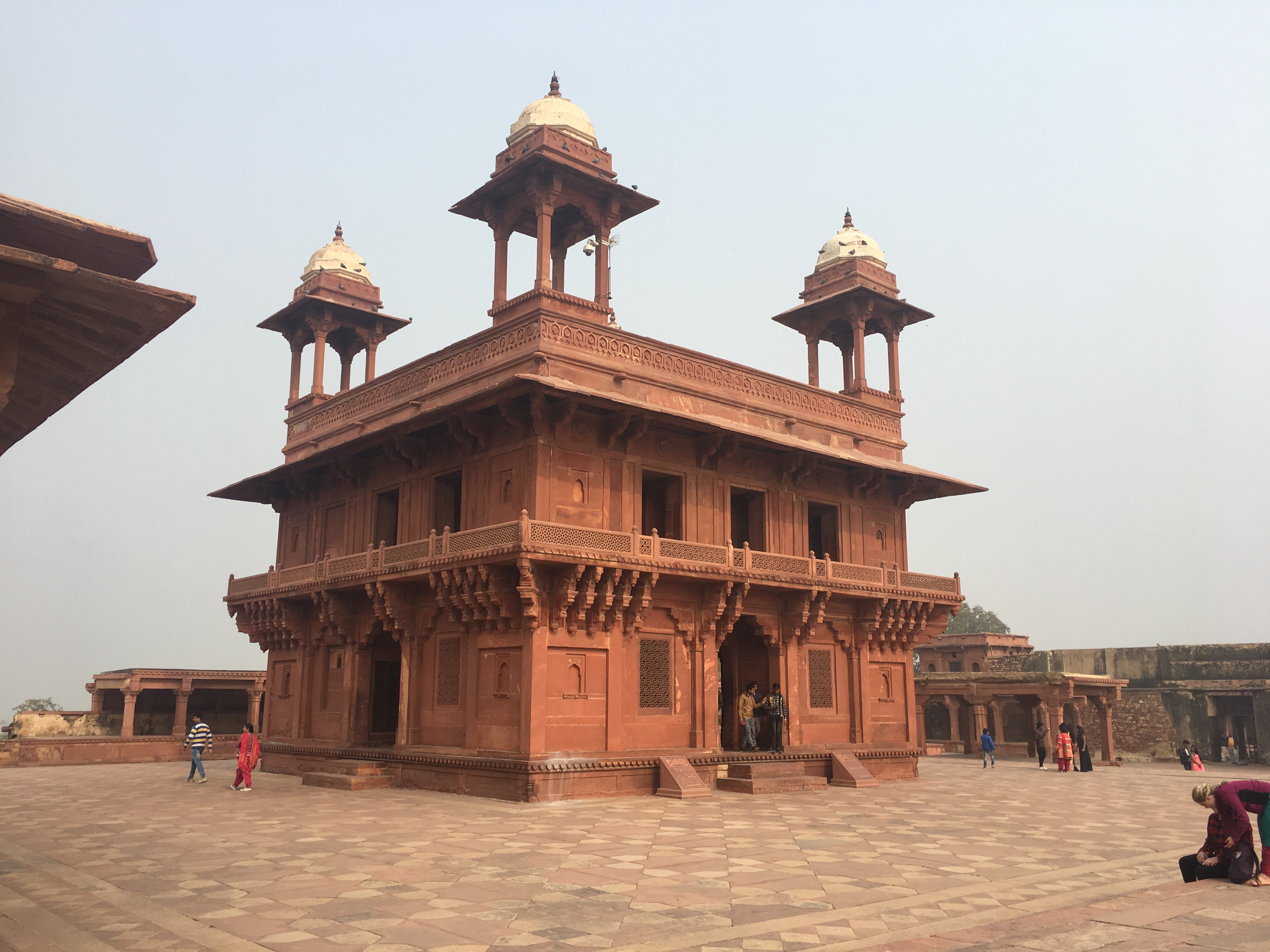
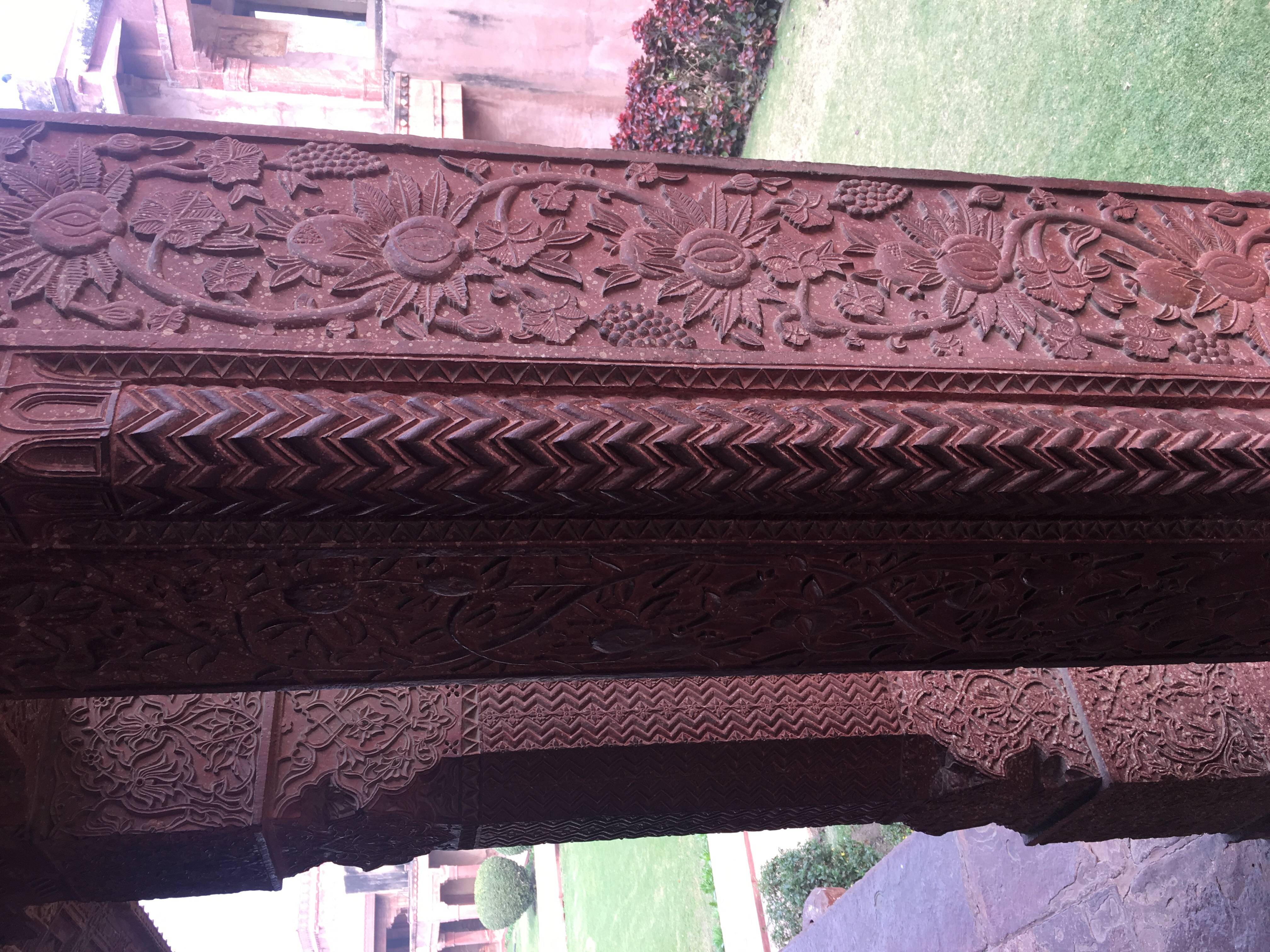
We’d picked up our local Agra guide, Johnny*, at the entrance to the fort, and he showed us around the enormous fort, with its areas for public and private meetings with the emperor, courtyards, apartments and facility areas. There was even a school. The three wives each had an apartment, the wives were respectively Muslim, Hindu and Christian and their apartments reflected this. The Hindu wife was the only one to have produced a son, and her apartment was consequently about five times the size of the others!
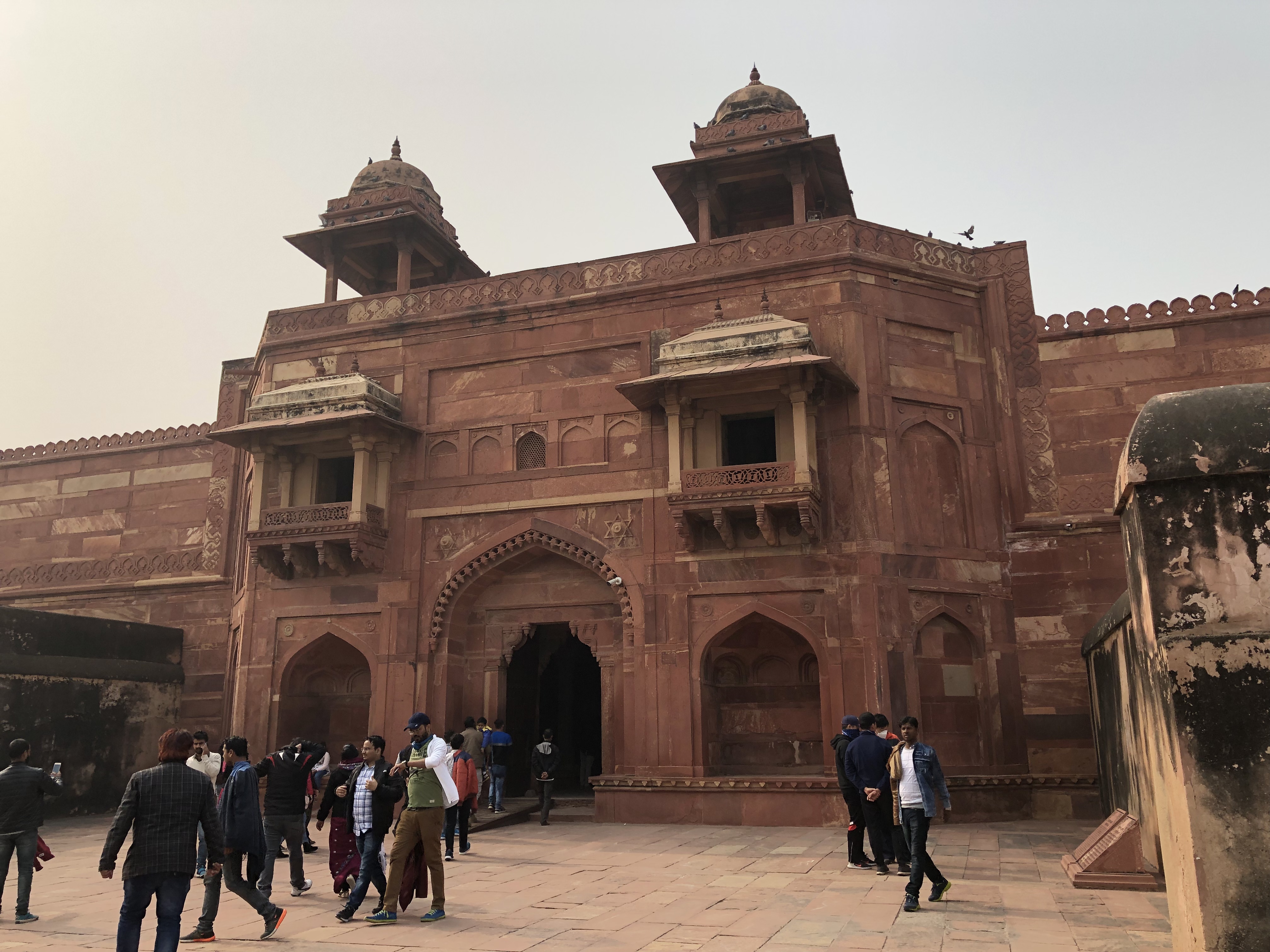
We walked down to the adjacent mosque with its enormous arch. It was an impressive building, beautiful in the usual geometric style. There was a change in ‘feel’ to this area – although part of the overall complex, it was a still a working mosque, and it didn’t feel right gawping touristically at the spectacle, so we didn’t stay long.
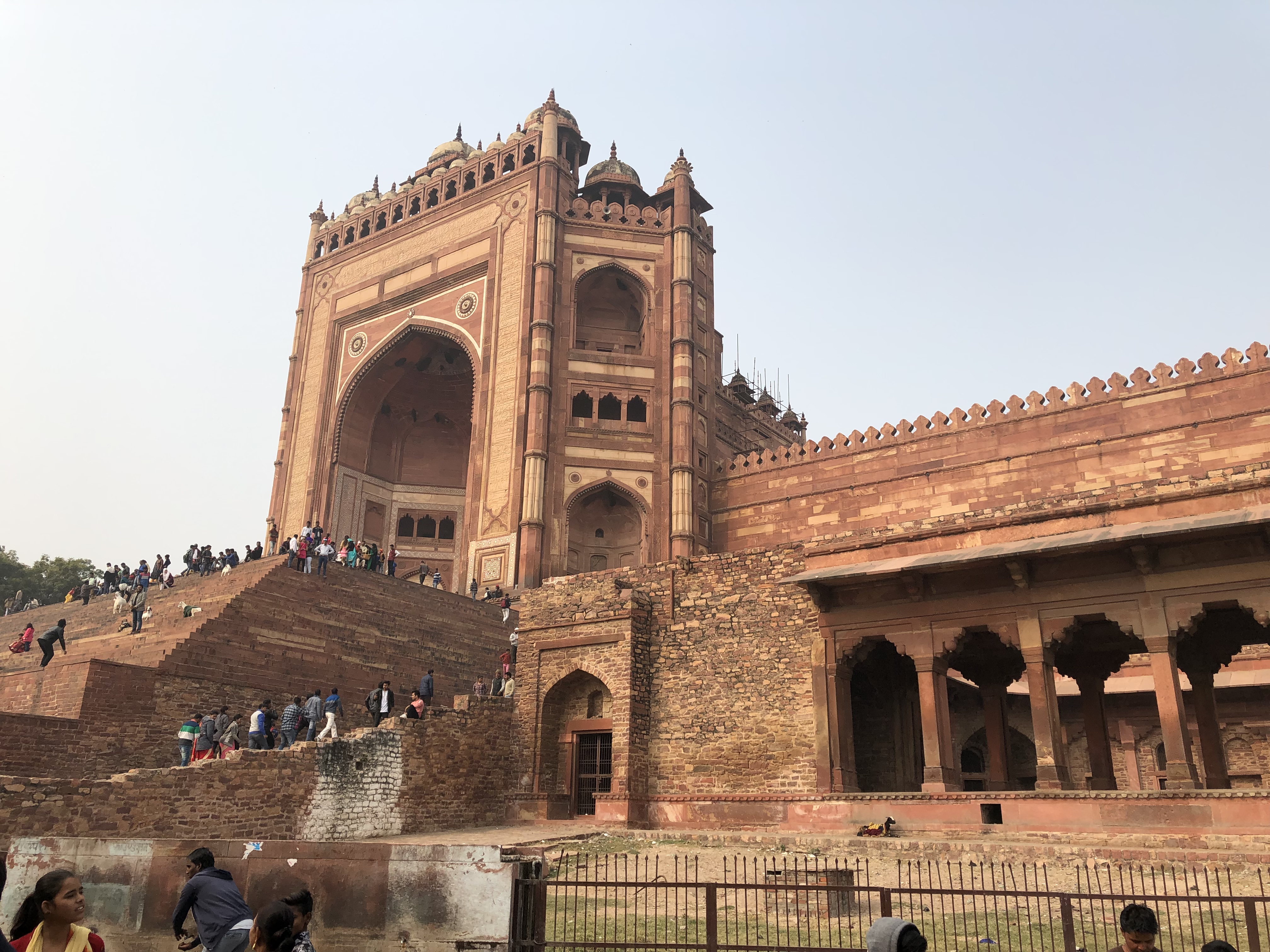
We took a horse-drawn carriage back to meet the car, had a quick stop for lunch (Channa Dal today, chickpeas, best yet!), and then it was on to Agra, for the Taj Mahal.
*’Johnny’ did give his proper name, which was a very complicated multi-syllabled twister of Western tongues, but said he went by the nickname ‘Johnny’. We supposed it was just a way of helping his charges, but he did take a phone call from someone later who addressed him as Johnny, despite them conducting the entire conversation in Hindi!
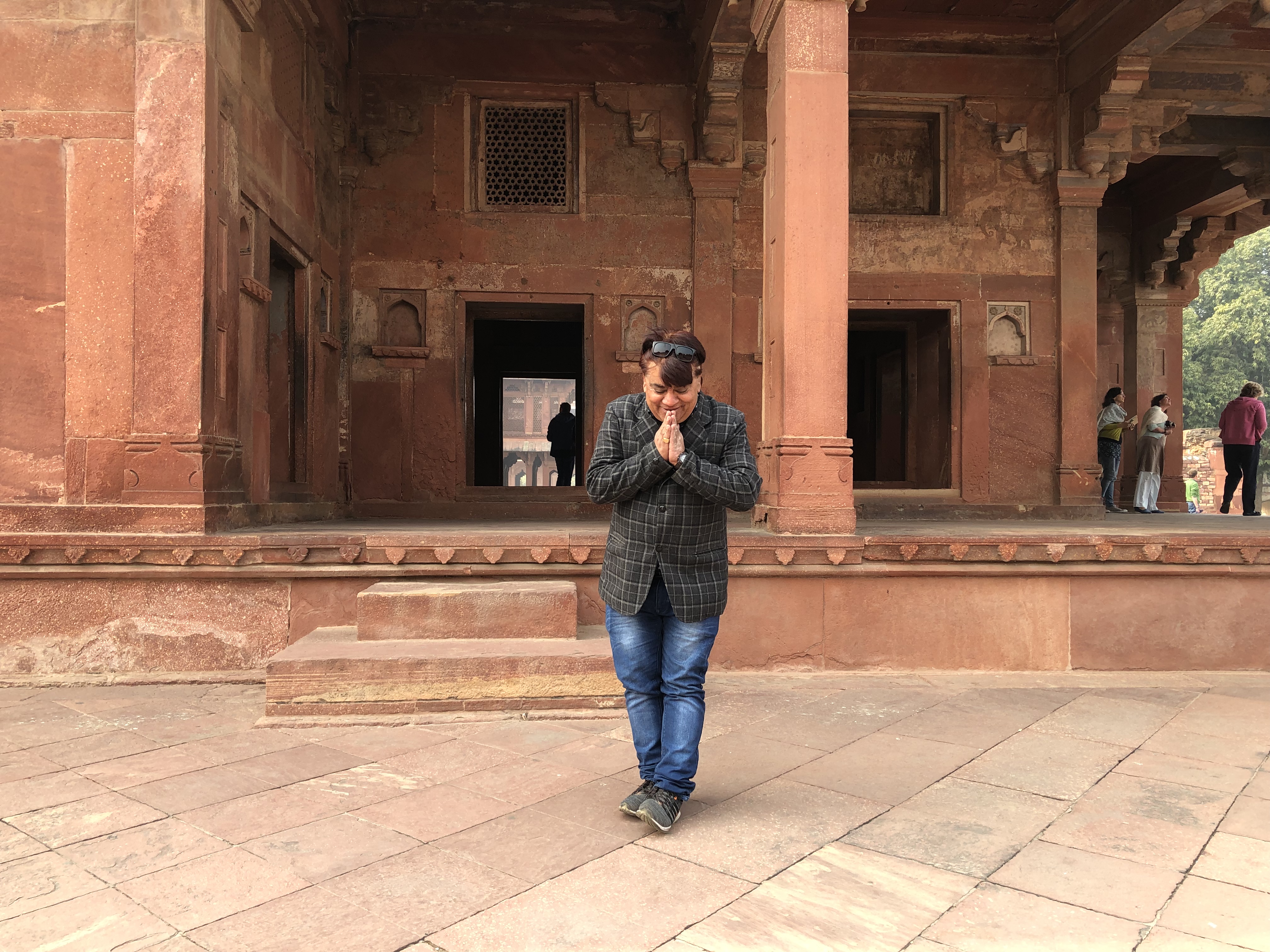
Johnny was keen to ensure that we arrived at the Taj Mahal in the late evening light. A certain tension seemed to arise in the car as he and Ramesh discussed the best way for us to reach the entrance on time, and this became heightened as we ended up on a street which was holding the weekly market. It took us forty minutes to drive a very short distance.
Nevertheless he declared himself satisfied, and we headed to a car park near the western gate, where a battery-powered vehicle took us the remaining few hundred metres to the gate itself. Security was tight, as usual, and once again we lined up in gender-segregated lines for the checks. We’d caught no glimpse whatsoever of the monument itself up to now, and as we entered the courtyard it remained hidden by an impressive red sandstone gatehouse providing an arched entrance. A line marked on the ground bisected the arch, and one could stand on it to look directly through and catch a tantalising glimpse of the Taj Mahal.
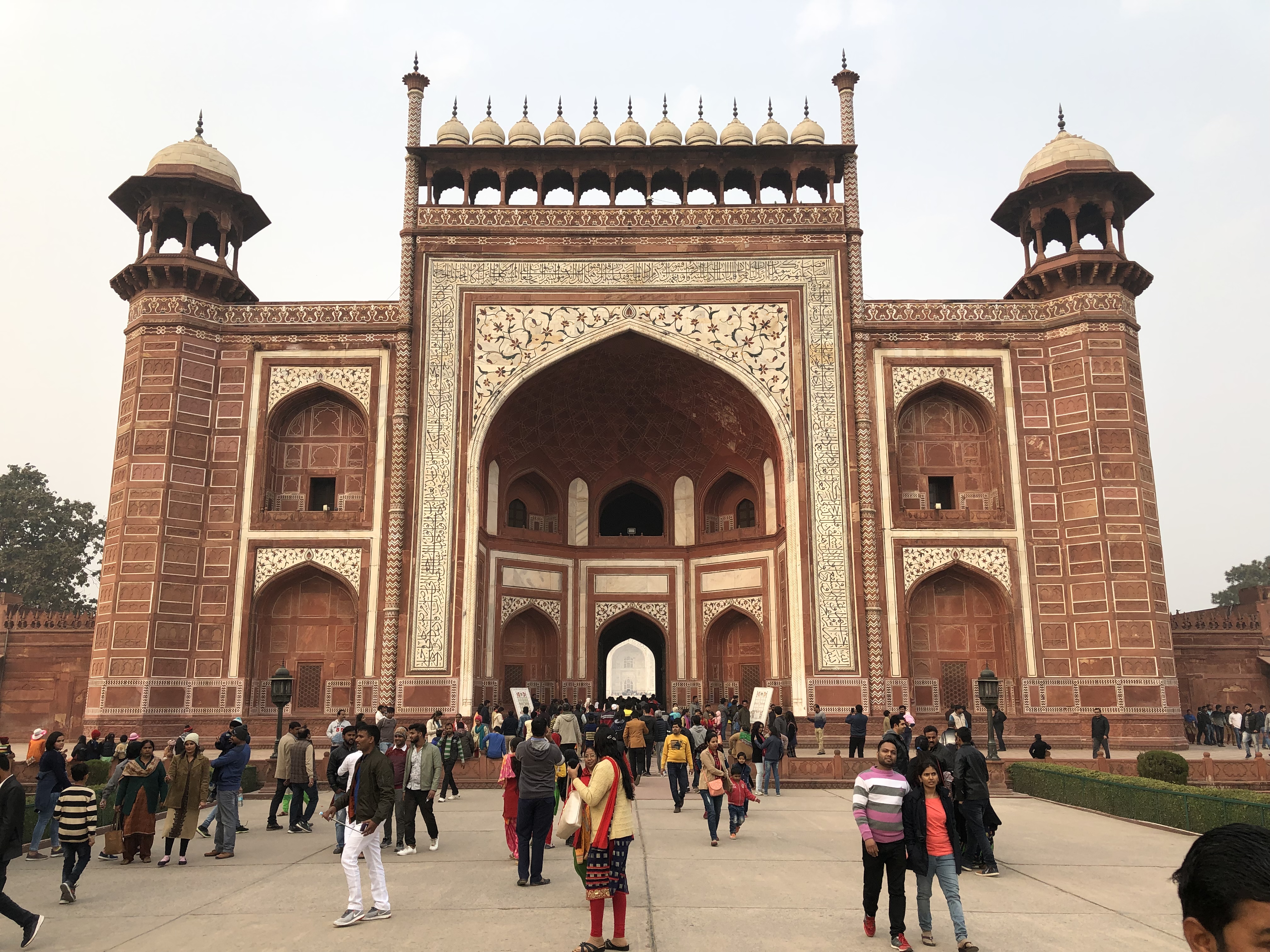
We’ve seen many pictures of the Taj Mahal over the years, of course, and have heard testimonials to its beauty. Despite this we doubted (a little) whether it could possibly live up to the advance billing. It did, though, it really did. It stands alone against the sky, a spectacularly beautiful edifice of white marble, symmetrical on all four sides, and perfectly judged to please the eye. I have never seen a more lovely building, and very much doubt I shall ever do so in the future.
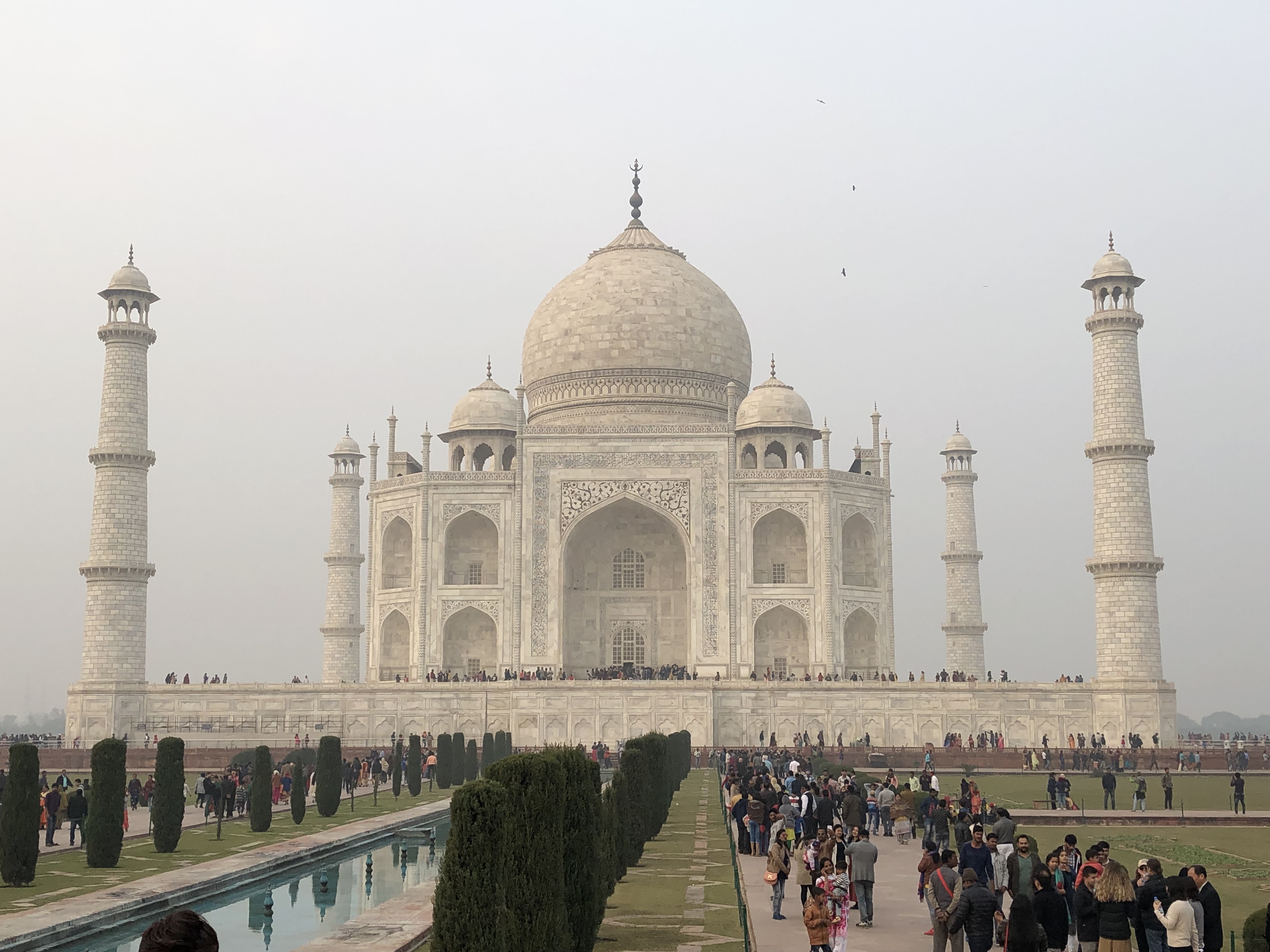
There were crowds, of course, taking pictures, selfies. Every time we looked back towards the building, though, every distraction seemed irrelevant. Between us we took many pictures, as the light seemed to change from minute to minute. Approaching the building itself we passed the infamous bench on which Princess Diana was photographed, which has acquired a status all on its own as a result of her fame.

A rectangular pool of blue water points towards the monument, and we walked along it. As we approached we had to don shoe covers before entering, to protect the marble floors. The walls are covered with enormous marble slabs, bordered by smaller ones inlaid with semi-precious gemstones (the precious ones having been robbed many years ago). Inside sit two replica toms (the real ones being ten metres beneath the floor). The first, of Mumtaz Mahal, to whom the building is dedicated, sits symmetrically across the straight line from the entrance courtyard. To the left is the slightly larger (and higher!) tomb of Shah Jahan, buried years after his favourite wife.
Thankfully I had my favourite wife with me, and we circulated the building together while Johnny described the history. Emerging into the evening light we wandered down to the northern face of the building, which looks down on the Yamuna river.
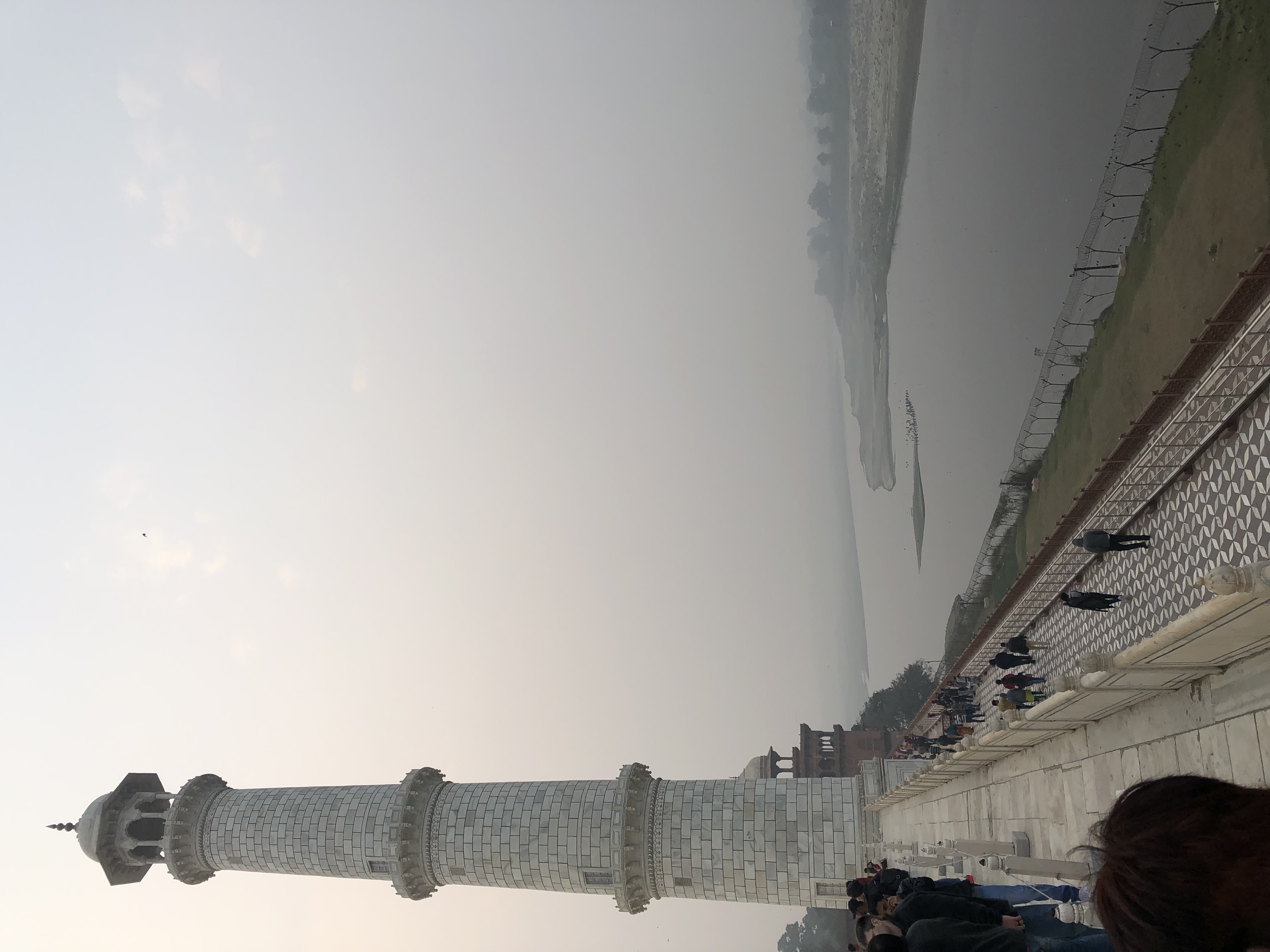
Walking back along the western side we spotted an eagle, sitting atop a waterspout.
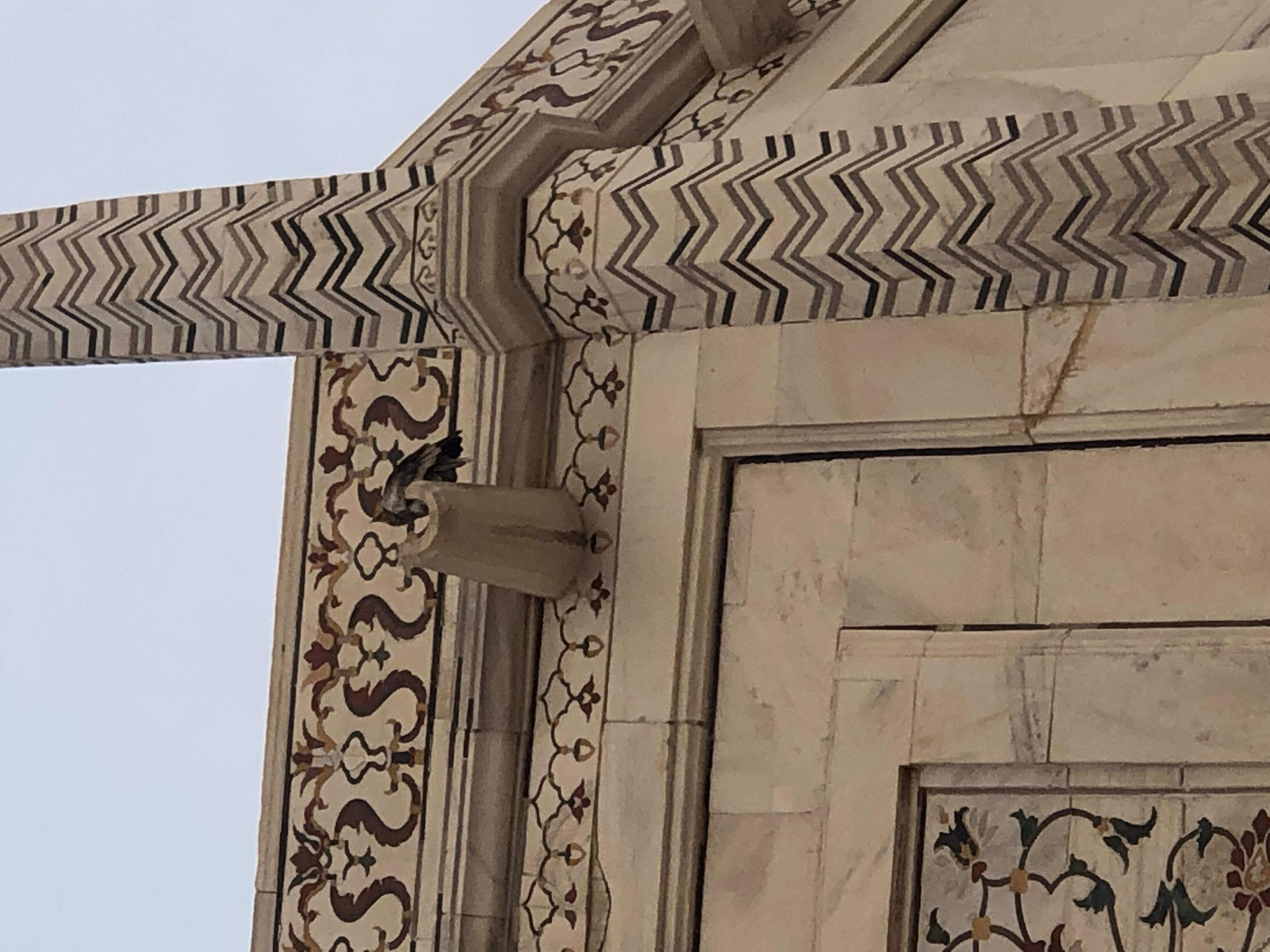
By now the light was starting to fade (and we knew that we would return for first light in the morning), so we walked back to the gate and located Ramesh, who drove us to our hotel.
We were happy but weary, and settled for a simple meal in the hotel in the evening.
This morning we awoke at six-thirty and grabbed a small breakfast (far too early to eat!) before heading back to the Taj Mahal with Ramesh and Johnny. The idea was to see how different everything looked in the morning light. We had an hour to wander around on our own, which we very much enjoyed – it did indeed look different as the sun rose – tinged with pink to start with, and later with a very pale yellow.
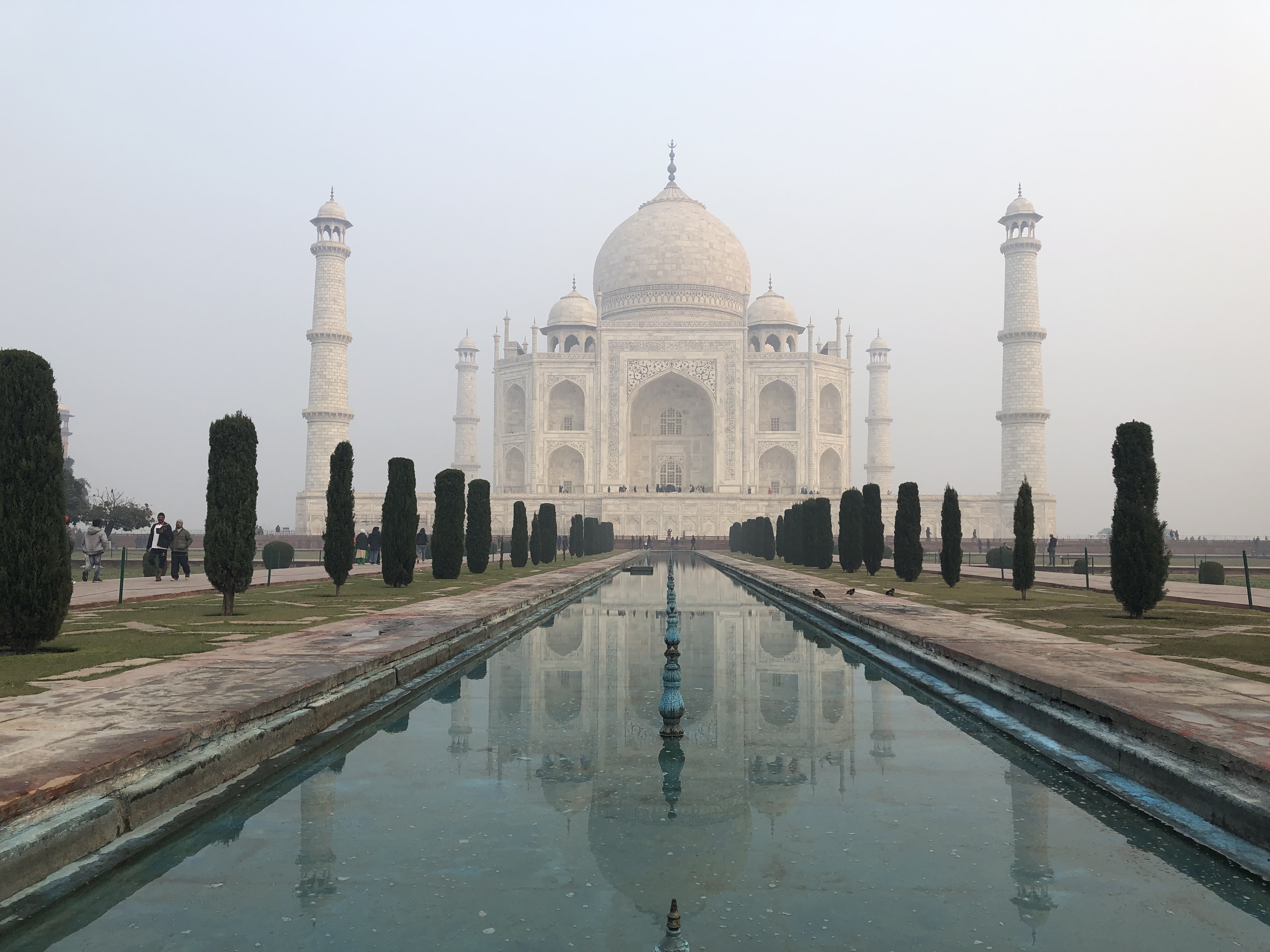
There were many fewer people there, which made photography easier, and allowed us to be a bit more playful!
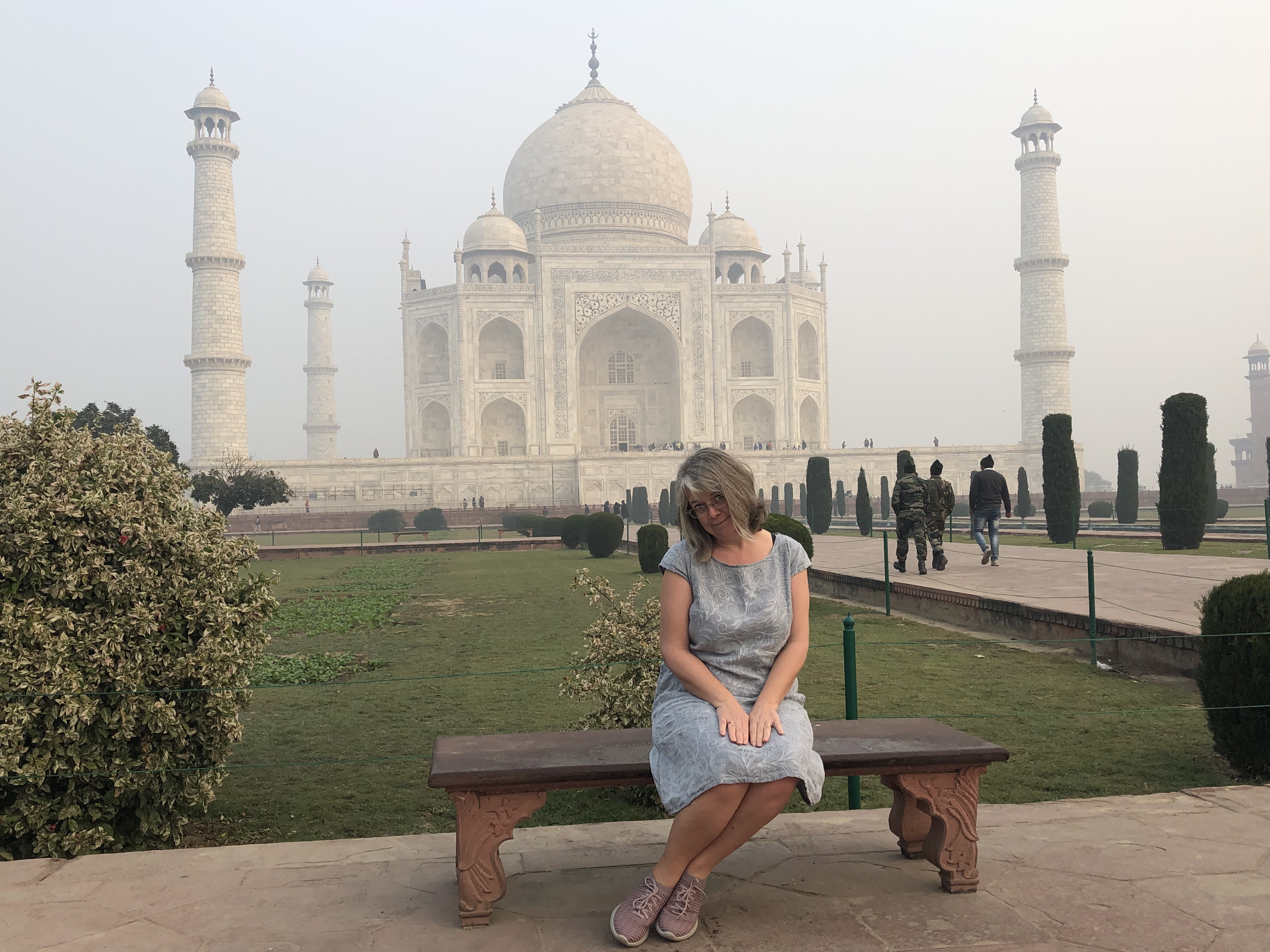
Again we spotted an eagle, but in addition today there were green parakeets and several monkeys. The monkeys scampered around, occasionally baring their teeth when humans approached too closely.
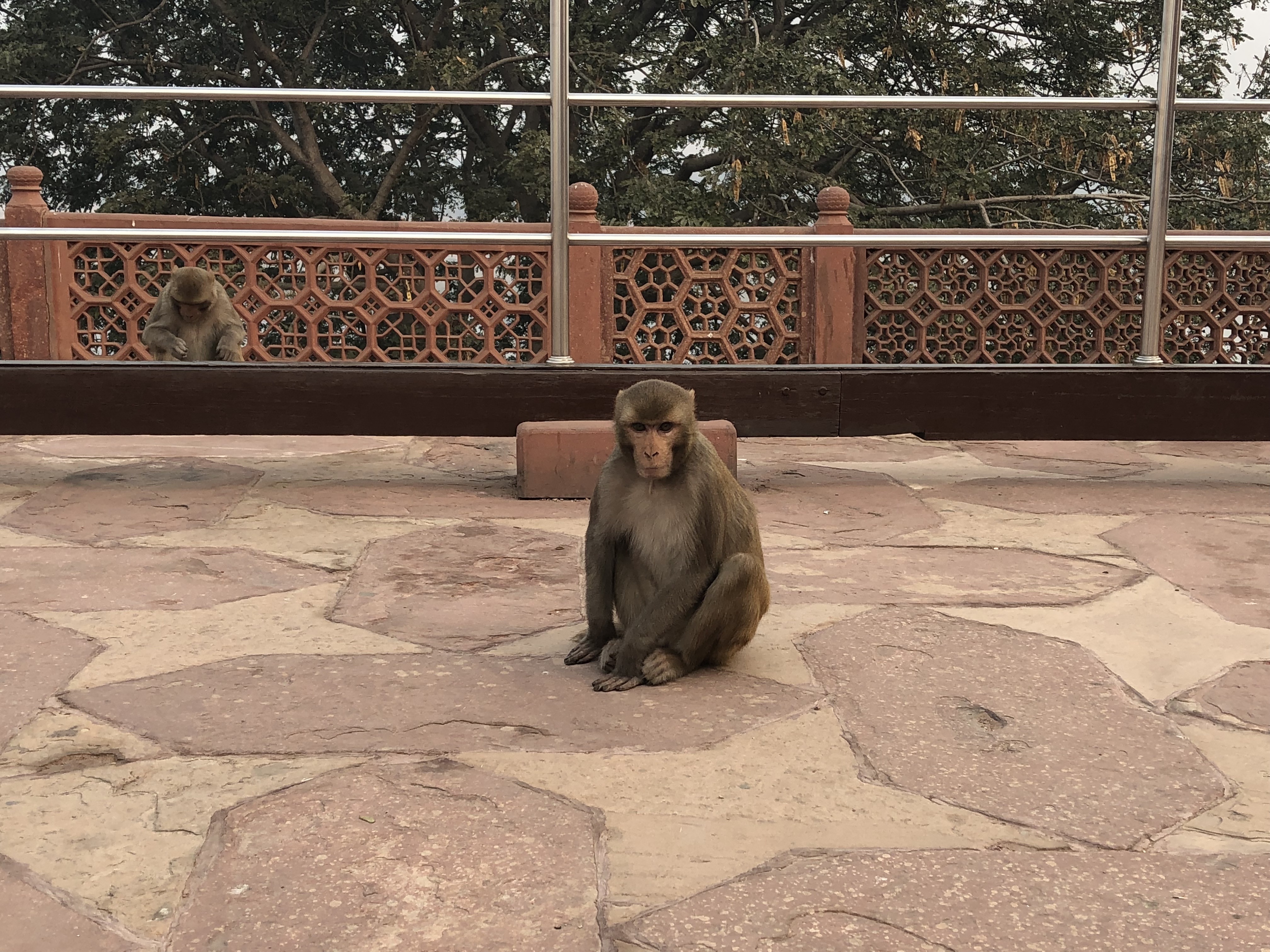
A couple of them, perhaps inspired by the romantic setting, became rather more amorous. We spent the remainder of our hour exploring the gardens, enjoying the different views. Then we returned to the vehicle and set off for Agra Fort.
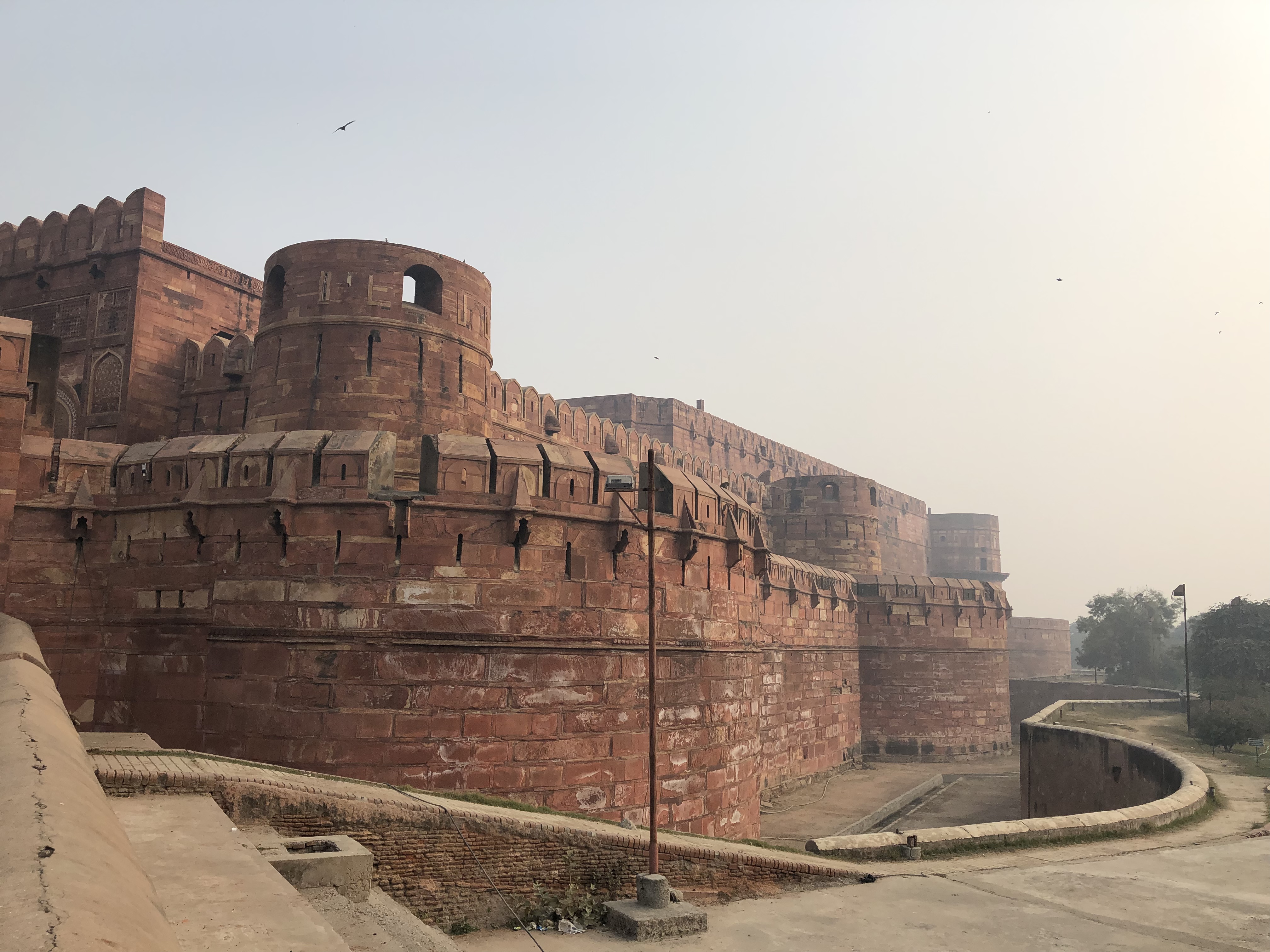
The fort, an enormous construction in red sandstone, sits about a kilometre upstream from the Taj Mahal. Three-quarters of it belongs to the Indian Army, the remainder is open to the public. Defensively it appears extremely strong, entrance to the main courtyard in particular is shielded by a lengthy sloping corridor designed to amplify the noise of attacking cavalry in order to warn the occupants. This Johnny (and every other guide) demonstrated by clapping his hands repeatedly to simulate the effect, no coconuts being available.
The fort was built by the third Moghul emperor (Shah Jahan being the fifth) when a move from Fatehpur Sikri was necessitated by the poor water supply there. Much later on a recurrence of the same issue required a further move, this time to Delhi.
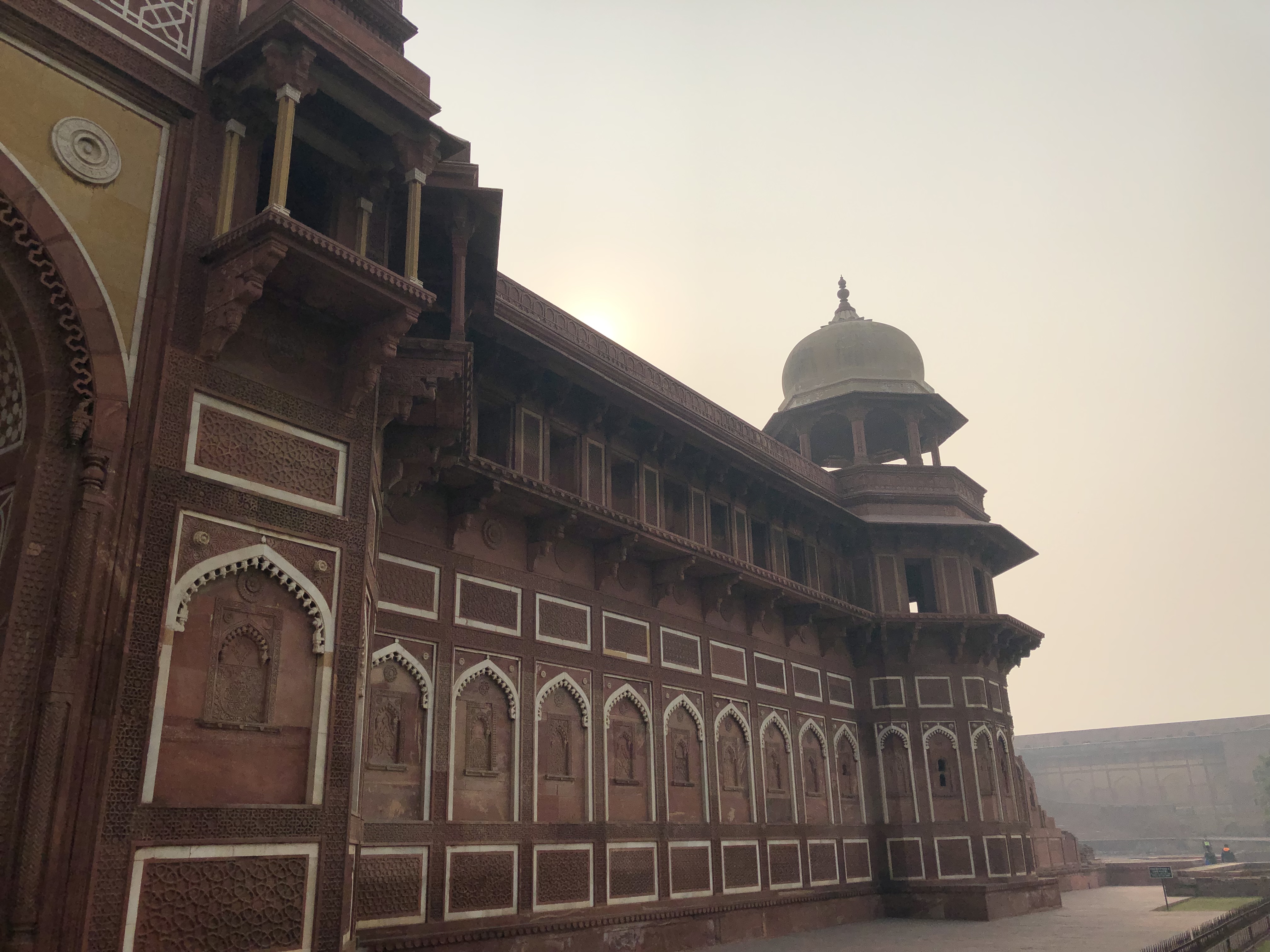
Anyway, back to our hero, Shah Jahan. Apparently once Mumtaz Mahal had died and he had finished building the Taj Mahal in her honour, he planned to build his own resting place, in pure black, across the other side of the river. It was at this point that his son stepped in, accusing him of spending the kids’ inheritance (much as we are doing on this trip ????). So he imprisoned his father in Agra Fort for the remainder of his life, with just his two remaining daughters for company. Talk about ungrateful!
Our tour, then, mainly took in the opulent accommodation designed for Shah Jahan and his daughters. While most of the fort is built of red sandstone, pure white marble predominated in these rooms – a central one for Shah Jahan and two equally sized ones on either side, one for each daughter. The opulence of their decoration almost matched that of the Taj Mahal, so obviously his son did provide some pocket money.
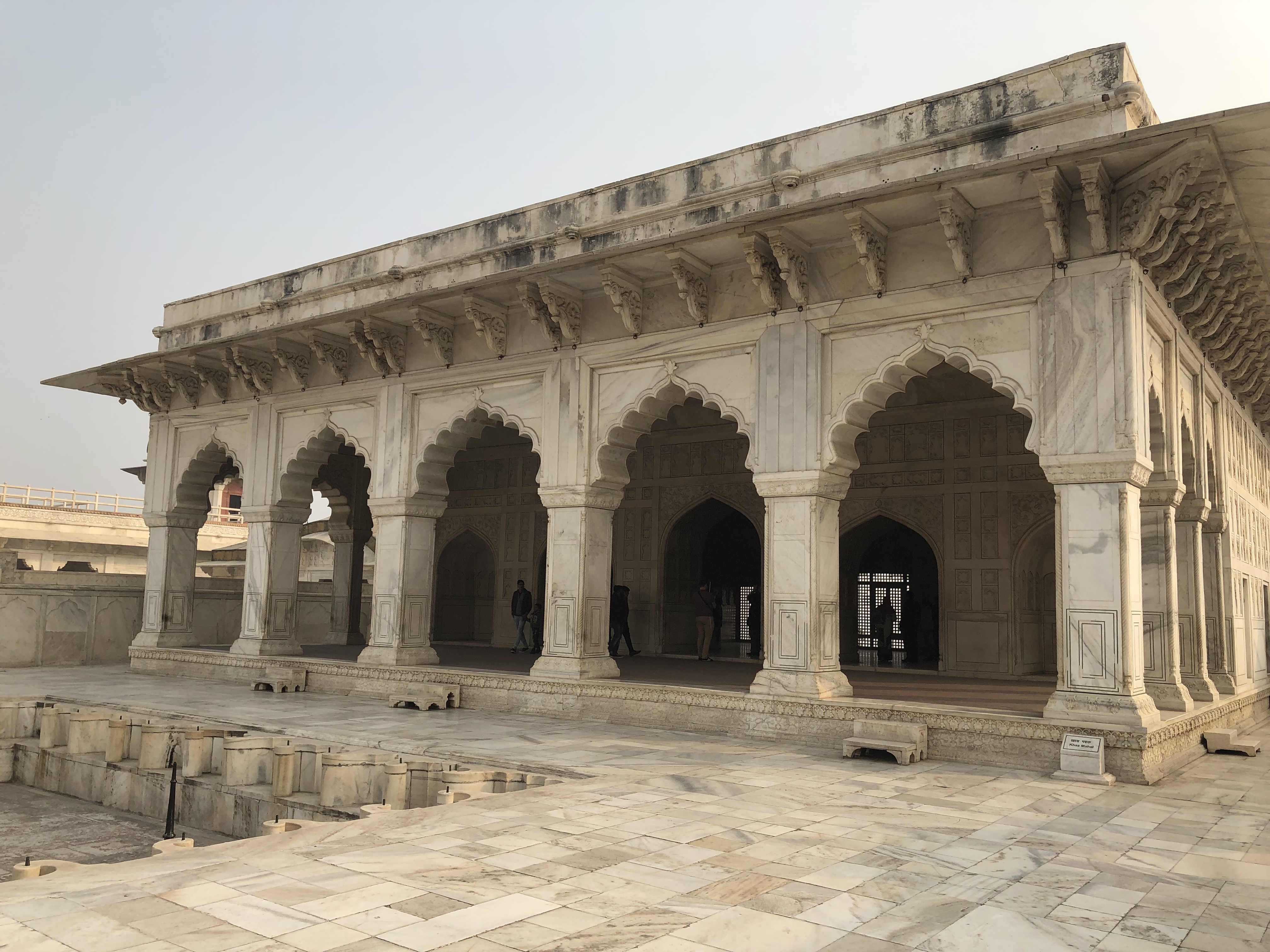
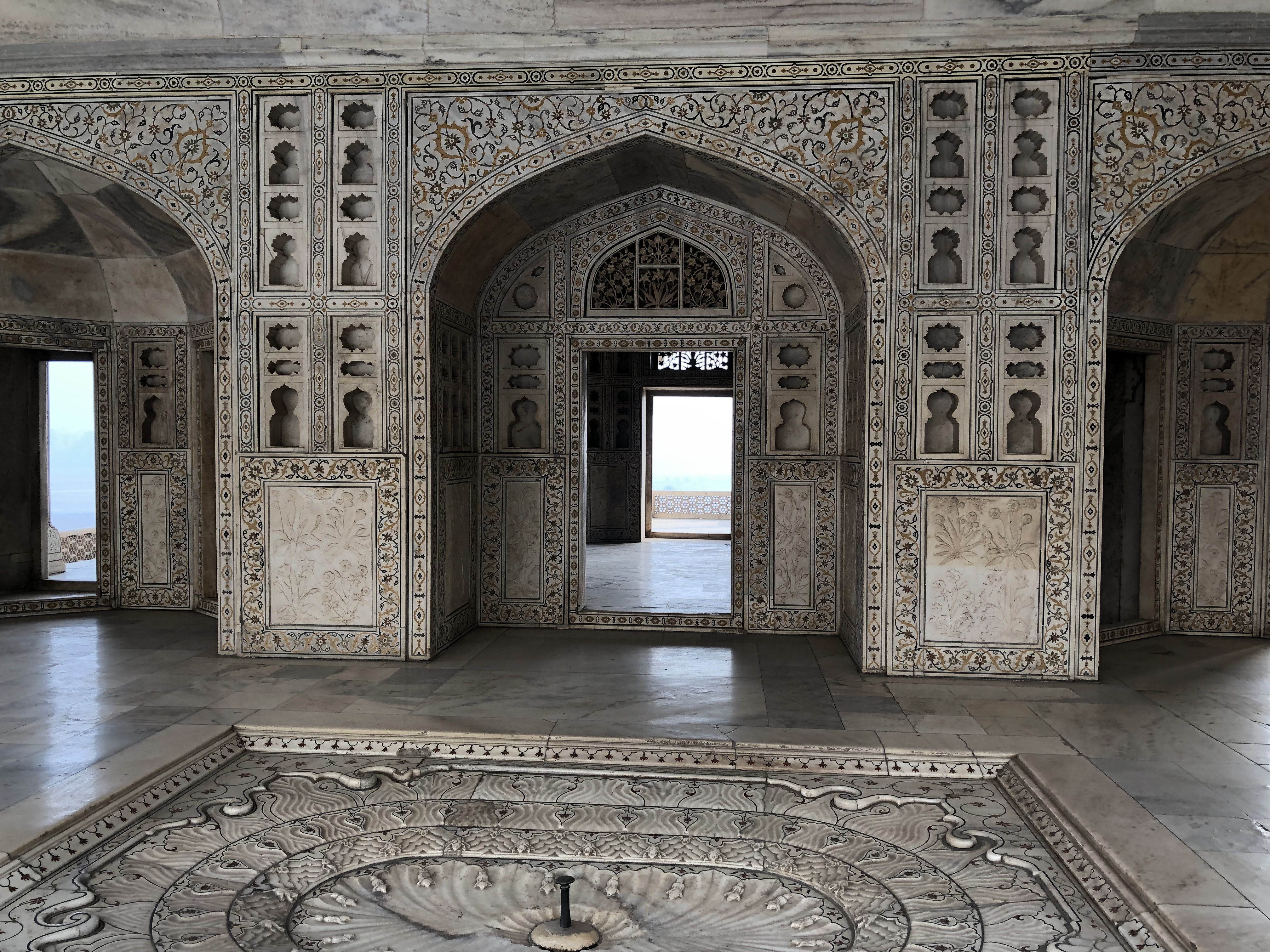
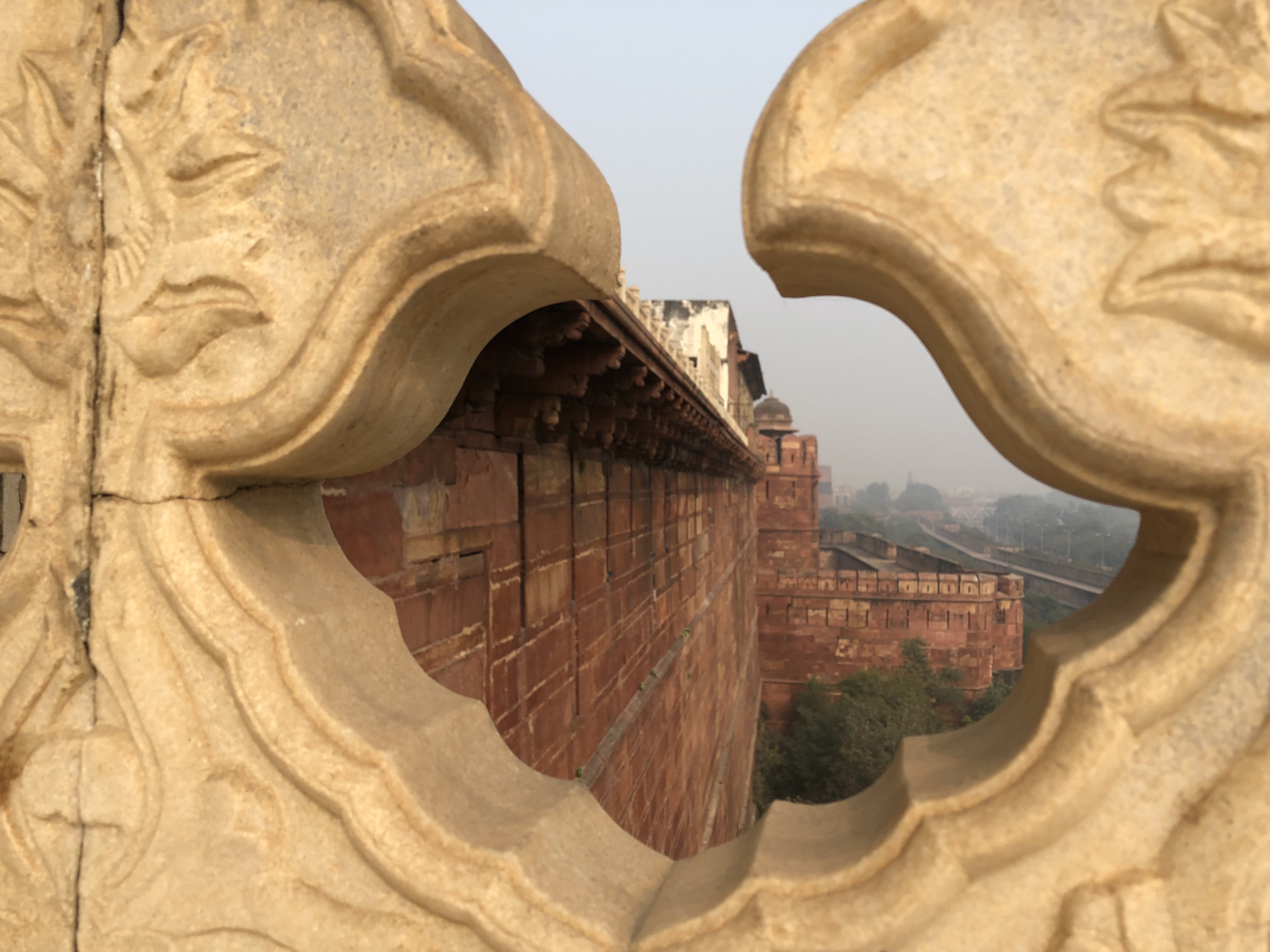
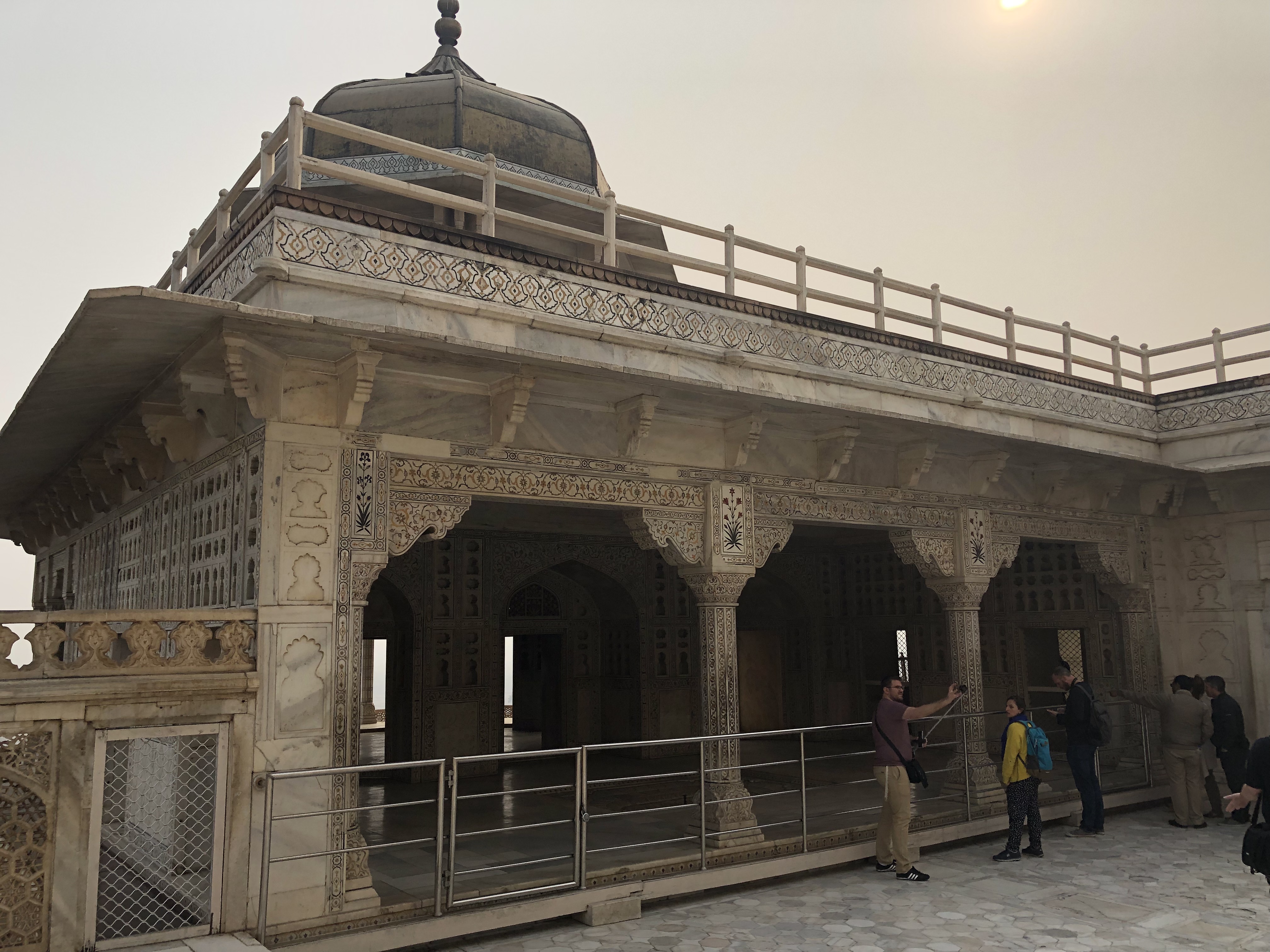
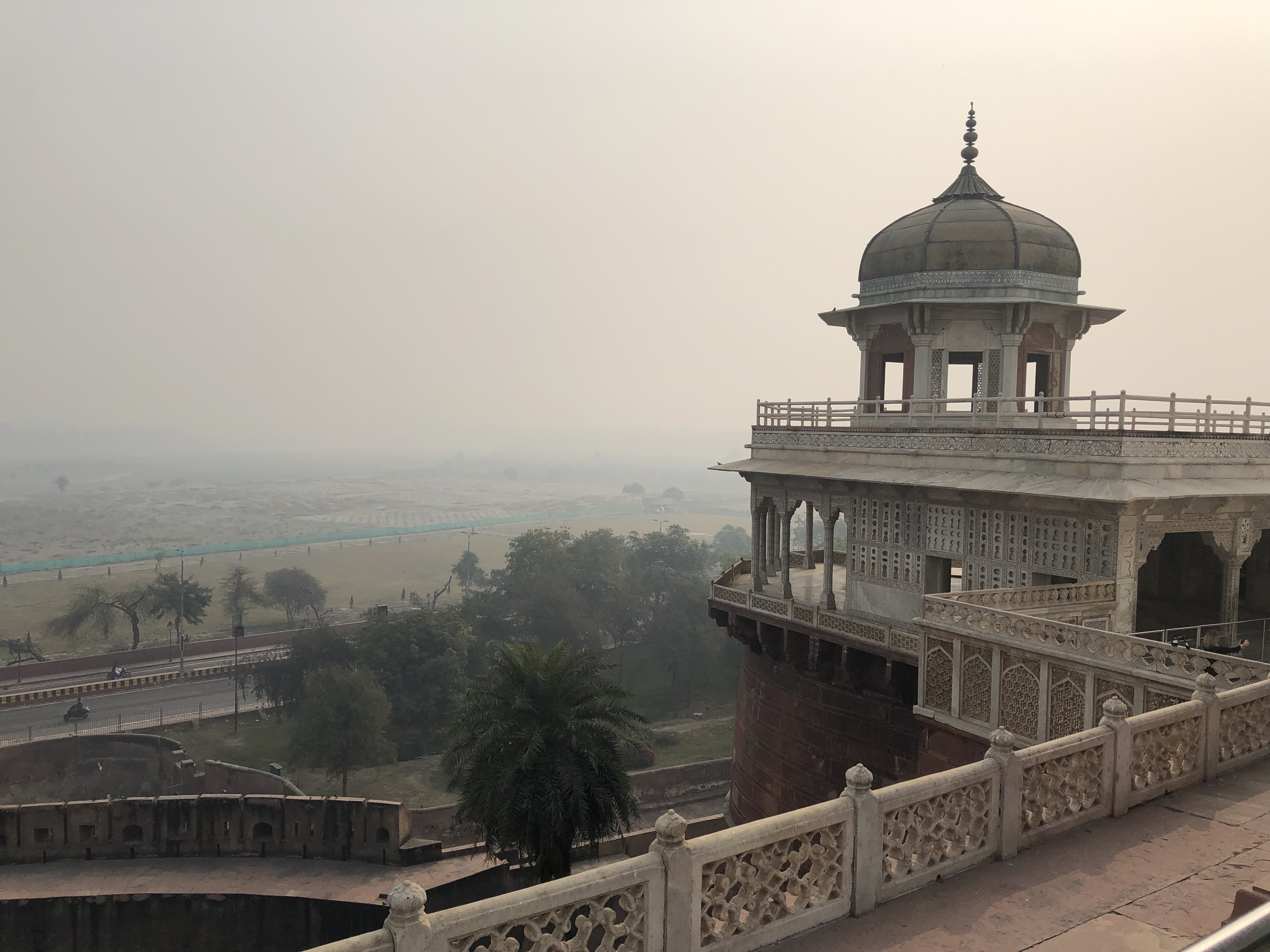
We looked out over a riverside balcony, seeking the Taj Mahal. Sadly, in the morning mist, we could just barely make out the minarets and the vague shape of the dome.
As we were leaving Johnny found some enterprising souls in the garden who were using crushed biscuits to persuade the tiny squirrels onto the hands of passing tourists. Not wishing to be left out we allowed ourselves similarly to be persuaded.
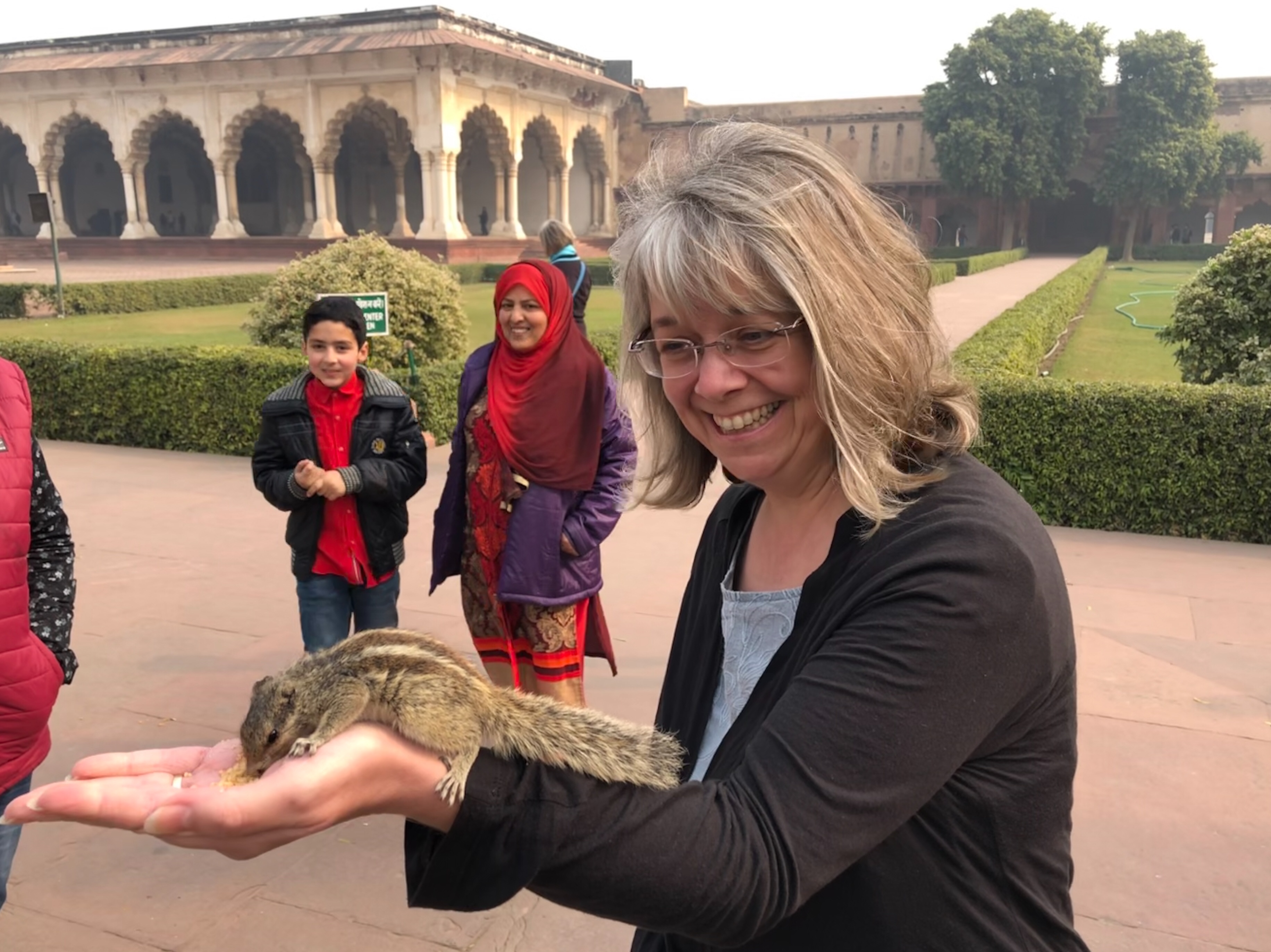
Thereafter we had a couple of more-or-less obligatory “shopping” stops, one to a place specialising in marble tables, and one to a gemstone and jewellery workshop. How I loathe the pretence of these visits – the insistence that all their stock is hand-made on site (given the level of activity it clearly isn’t) and the slow but inevitable build-up to “Would you like me to tell you some prices?”. Bah, humbug! Alright, maybe we bought one small but rather lovely pendant, but because it was lovely, not because we were taken in, right?!
Back to the hotel then, for a late checkout before a journey back to Delhi by train. As Ramesh was driving us to the station he pointed out two tuktuks – one had run out of fuel, so the other was assisting it to get to the petrol station by driving behind the tuktuk and extending his foot to push it when it ran out of momentum!
Tomorrow we intend to have a lie-in and a lazy day before transferring to the airport for our flight to Colombo. India has provided a wonderful start to the trip, some delicious food and a whole host of memories.
